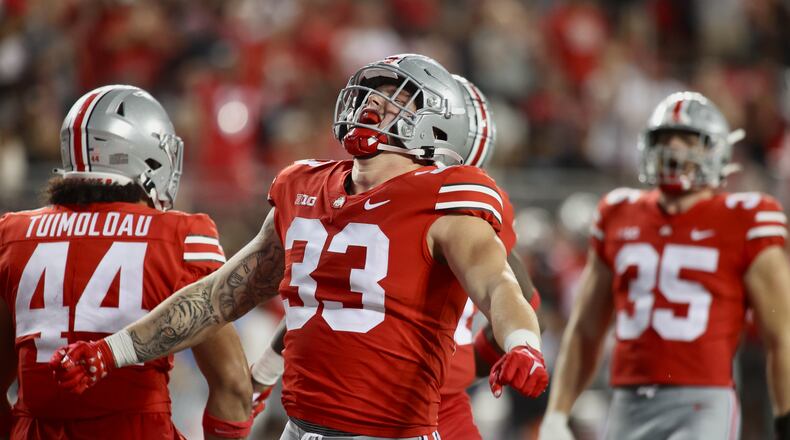That marked the latest twist in the story of a position that ended up getting a lot more inches in print and pixels online than it did snaps on the field last fall.
First, Knowles was calling it the “Leo.” Then he said the name would be “Jack” until someone rose above the rest to make it there own because Leo is for lion, the king of the jungle.
He envisioned using the Jack, a hybrid defensive end/linebacker, one third or even 40 percent of the time, but that number ended up at more like 15 according to Knowles.
The reason?
“We weren’t as productive out of it,” he said. “You have to go with what works.”
To make matters worse, trying coincidentally named sophomore Jack Sawyer at the position might have stunted his growth, so Sawyer is going to be a full-time defensive end this spring in an effort to help him reach the potential he brought as a five-star recruit two years ago.
However, if the position is out of sight over the 15 practices, it is not out of Knowles’ mind.
In fact, he already has at least one player in mind for it who is not full-go this spring as he recovers from a knee injury suffered in the 2022 spring game: Mitchell Melton.
“I want to see him back to where he was, right?” Knowles said. “I thought he had a real chance. So we moved him from a linebacker to the front when I got here and then started experimenting with him in the Jack position and he jumped out. He jumped out. He really did.”
Melton is able to do individual work but is sitting out team drills in hopes of getting him to the fall at full strength.
He could make sense as the Jack because he is something of a ‘tweener. At 6-foot-3 and 245 pounds, he is on the big side for a modern linebacker in today’s college football and small for a typical end.
Knowles said in the future the staff will look for potential Jacks in recruiting and indicated athletes without an obvious position would be the blueprint, at least as much as there is one.
“No, I mean I think he could be a tailback,” Knowles said, repeating a previously told anecdote about his first Jack/Leo being MAC Defensive Player of the Year and 10-year NFL player Jason Babin at Western Michigan.
“He was a tailback in high school, so I think what you’re looking for is someone who’s just an extremely productive football player but doesn’t fit into anyone’s mold. That guy the D-line coach says is not big enough or the linebacker coach says he doesn’t read well enough. The running back coach says, ‘Well, he’s a really good player, but he’s not one of the top three running backs in the country.’ And I feel like eventually we’ll have something to sell in that area. We’re Ohio State.”
Tegra Tshabola of Lakota West potential starter on Ohio State offensive line https://t.co/MGBqeZq7UA
— Marcus Hartman (@marcushartman) March 9, 2023
Although the “Jack” is a common name for one of the outside linebackers in various versions of the 3-4 defense, and Ohio State once called its rush end the “Leo” during the Jim Tressel era, the position in Knowles’ defense is unique from both.
He has described it as a chess piece that can be moved around the defensive front to mess up blocking schemes and “play offense on defense.”
Aside from being a home for an overlooked recruit, it could ironically be an outlet for getting one of Ohio State’s top recent recruits onto the field, too.
Knowles said he has considered trying C.J. Hicks, a sophomore linebacker stuck behind veterans Tommy Eichenberg and Steele Chambers, at the Jack when it does return.
Hicks, who played just about every position at Alter High School, endorsed that idea Thursday even though he had not actually spoken to Knowles about it himself.
“I feel like I can be a good player at the Jack,” the 6-3, 230-pound Hicks said. “You know, in high school I rushed the passer a lot, but it’s up to Coach Knowles and his defense.”
About the Author

